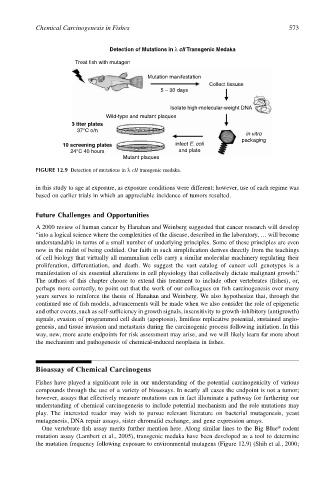Page 593 - The Toxicology of Fishes
P. 593
Chemical Carcinogenesis in Fishes 573
Detection of Mutations in λ cII Transgenic Medaka
Treat fish with mutagen
Mutation manifestation
Collect tissues
5 – 30 days
Isolate high-molecular-weight DNA
Wild-type and mutant plaques
3 titer plates
37°C o/n
in vitro
packaging
10 screening plates infect E. coli
24°C 40 hours and plate
Mutant plaques
FIGURE 12.9 Detection of mutations in λ cII transgenic medaka.
in this study to age at exposure, as exposure conditions were different; however, use of each regime was
based on earlier trials in which an appreciable incidence of tumors resulted.
Future Challenges and Opportunities
A 2000 review of human cancer by Hanahan and Weinberg suggested that cancer research will develop
“into a logical science where the complexities of the disease, described in the laboratory, … will become
understandable in terms of a small number of underlying principles. Some of these principles are even
now in the midst of being codified. Our faith in such simplification derives directly from the teachings
of cell biology that virtually all mammalian cells carry a similar molecular machinery regulating their
proliferation, differentiation, and death. We suggest the vast catalog of cancer cell genotypes is a
manifestation of six essential alterations in cell physiology that collectively dictate malignant growth.”
The authors of this chapter choose to extend this treatment to include other vertebrates (fishes), or,
perhaps more correctly, to point out that the work of our colleagues on fish carcinogenesis over many
years serves to reinforce the thesis of Hanahan and Weinberg. We also hypothesize that, through the
continued use of fish models, advancements will be made when we also consider the role of epigenetic
and other events, such as self-sufficiency in growth signals, insensitivity to growth-inhibitory (antigrowth)
signals, evasion of programmed cell death (apoptosis), limitless replicative potential, sustained angio-
genesis, and tissue invasion and metastasis during the carcinogenic process following initiation. In this
way, new, more acute endpoints for risk assessment may arise, and we will likely learn far more about
the mechanism and pathogenesis of chemical-induced neoplasia in fishes.
Bioassay of Chemical Carcinogens
Fishes have played a significant role in our understanding of the potential carcinogenicity of various
compounds through the use of a variety of bioassays. In nearly all cases the endpoint is not a tumor;
however, assays that effectively measure mutations can in fact illuminate a pathway for furthering our
understanding of chemical carcinogenesis to include potential mechanism and the role mutations may
play. The interested reader may wish to pursue relevant literature on bacterial mutagenesis, yeast
mutagenesis, DNA repair assays, sister chromatid exchange, and gene expression arrays.
®
One vertebrate fish assay merits further mention here. Along similar lines to the Big Blue rodent
mutation assay (Lambert et al., 2005), transgenic medaka have been developed as a tool to determine
the mutation frequency following exposure to environmental mutagens (Figure 12.9) (Shih et al., 2000;

